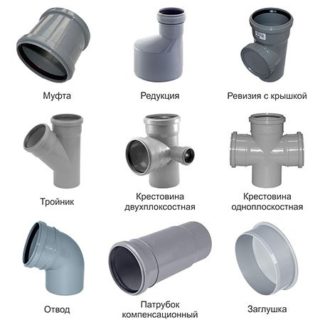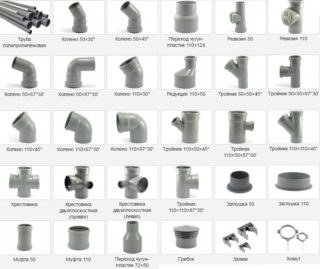Sewer fittings are important parts of a sewage system. They are used for joining pipe sections into a single network and when assembling plumbing equipment at the time of connection to the sewage main.
Applications and materials

Previously, the installation of the sewage system was carried out on the basis of cast iron pipes with metal fittings. The assembly required the use of various types of welding.
Modern household fecal pipelines inside and outside buildings, as well as drainage lines, are completed from plastic parts.
Polymer products are resistant to almost all types of aggressive media, are lightweight, have a long service life and are easy to install. Their use significantly increases the operational indicators of engineering communications, reduces the cost of their arrangement.
Products made of polyvinyl chloride are popular due to their low weight and budget cost. Shaped PVC elements are used to divert:
- permanent wastewater in the sewage system with a temperature of no more than 80 degrees;
- short-term drains with a temperature of 95 degrees;
- chemical liquids with a pH value of two to twelve.
Fitting elements made of polypropylene and polyethylene are more durable, flexible and less susceptible to temperature changes in comparison with polyvinyl chloride counterparts. Pipes made of these materials can be used for any type of sewer installation, including hidden under plaster. High-strength fittings PPRC are allowed to operate under pressure up to 25 MPa, which is important for pressure sewers.
Types of sewer fittings
For internal pipelines, other types of fittings are also used:
- Bends - for arranging turns when installing nearby branch lines.
- Reductions - for the transition between sewerage sections of different diameters, as well as for joining cast iron and polymer mains.
- Compensating pipes - to eliminate breakdowns by replacing the damaged part of the pipeline.
- Revisions - to clean clogged pipes. They are equipped with a screw cap and are mounted in easily accessible places.
- Saddles - when connecting an additional branch to an already operating line. They sit on the glue, clasping the main pipe, and a branch is connected to the socket.
- Plugs - to block the transported wastewater during repair work or revision.
An aerator or a sewer valve is necessary to block the ingress of gases into the sanitary room through the toilet due to the rarefaction of air in the drain pipe, which leads to the pulling of the water seal from the siphon.
Shaped parts for external sewerage are similar in design and purpose to analogs mounted inside a building. But they are much stronger and painted, like pipes for external work, in a red color. This allows you to quickly detect the highway against the background of dark ground.
When arranging an external pipeline, check valves and two-knee siphons are used. The first element is necessary to block the return of drains and is always mounted on pipelines laid with a slope of less than two centimeters. The siphon acts as a connector for two parallel pipe sections. The bend obtained at the docking area does not allow gases to go into the bathroom.
Dimensions of fittings
Inside the building, pipes of the following diameters are used to drain wastewater:
- from the shower, washbasin, bidet, sink, bathroom - 40 mm;
- from the toilet and the central riser - 110 mm;
- from the main riser - 60 mm.
The bathtub, shower and washbasin combination waste is fitted with 50mm fittings.
For laying communication networks outside the building, fittings with a diameter of 160-200 mm are chosen.
The size ratio of commonly used fittings for PVC sewer pipes is clearly shown in the table:
| Element | Diameter (mm) | Length (mm) |
| Clutch | 110–400 | 120–330 |
| Revision | 50–315 | 167–500 |
| Diversion | 110–400 | 15–90 |
| Compensation pipe | 50–500 | 170–320 |
| Check valve | 110–250 | 300–520 |
| Two-piece siphon | 110–200 | 510–820 |
Tees with an angle of 45 degrees are produced with a diameter of 110–400 mm, the length of their lateral sockets is 140–530 mm, and the height from the end to the socket protrusion is 140–500 mm.
Selection rules
When selecting fittings, it is worth considering the following points:
- Before buying, you should create a project with the marking of all spillway points and plumbing fixtures. He will help determine the required number of fitting parts.
- The material of the connecting elements must be the same as that of which the sewer pipes are made.
- To join the metal part of the pipeline with the polymer branch, you will need fittings for a threaded connection from one end.
- It is advisable to purchase fitting elements from the same manufacturer as the pipe sections. When purchasing products, you should pay attention to the exact match in size.
As the number of fittings installed on the pipeline increases, the likelihood of blockages increases. Try to simplify the main geometry as much as possible, and install the fittings so that free water drainage is ensured.
Installation recommendations
- When cutting resin parts, use a fine-toothed saw or a piece of wire. Such a tool allows you to leave minimal scoring on the cut edge.
- After cutting, finish the saw cut. Removing burrs helps prevent blockages and ensures a tight fit.
- If voids form at the joint, treat them with glue using a brush.
When using glued fitting elements, the areas to be joined are first degreased, after which glue is applied. The composition is evenly spread with a brush, the excess is wiped off with a rag.
If purchased parts with rubber seals, silicone sealant is applied to the mating surfaces prior to assembly to reduce the risk of leaks.
It is necessary to insert the pipe not all the way, but so that a centimeter expansion gap is formed. Before doing this, make a preliminary connection and mark the insertion depth on the pipe.
Fittings for polyethylene and polypropylene sewer pipes can be connected to the mains not only by the socket method, but also by the hot welding method. It has its own characteristics:
- If the cross-section of pipe sections and fittings is less than 50 mm, you can use a household soldering machine.
- For the installation of large diameter pipes, you will need a centering unit.
- Aluminum-reinforced pipe sections are cleaned with a facing tool or shaver to a soldering depth before welding.
The soldering machine heats the ends, which leads to their softening. The parts to be welded are pressed against each other with their end surfaces, gradually increasing the pressure. It is important not to move pipes and fittings until the joint cools down to prevent movement. The connection is obtained as strong as possible, since the connection of parts occurs at the molecular level.
The correct choice of fittings and competent installation of the pipeline is a guarantee of a long service life of both the shaped elements themselves and the entire system.











